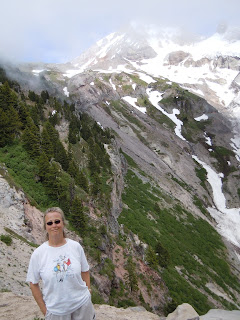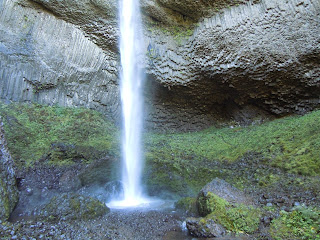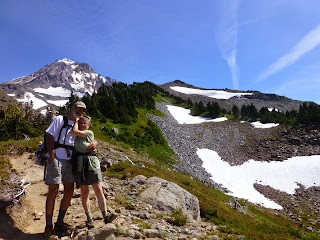I think everyone should be required to learn the geological history of their particular patch of the planet. It helps drill home the notion that life did not begin on the day of one’s own birth, and that, by corollary, we should not keep thinking we are so special. This is important. When we, as a group, begin thinking we are so special, we make decisions we might regret later.
I’ve been working on my own education. And what I’ve discovered is how many spectacular ways you could be dead right now if you’d started out 150 million years ago in Oregon, assuming the old age didn’t get you first. Oh sure, you’d have to contend with earthquakes and volcanoes just about anywhere, eventually, and certainly here, but we’ve had catastrophes other places can only dream about.
For starters, you’d have been screwed almost everywhere in Oregon 150 million years ago unless you could tread water for a very long time. There really wasn’t anything to plant a flag on. There were bunches of coral reefs and volcanic islands dotting the vast sea, happy and tropical, with no aspirations whatsoever to be welded to the landscape, whilst the Americas and Europe and Africa were jammed up and hunkering nearby. But once the Americas got the notion to make a break for it, it was Westward Ho at ramming speed. The islands, meanwhile, were moseying east, all unawares, and then, suddenly–like over the course of sixty million years–they were mashed into the continent. A bunch of them are currently mountains in the northeast corner of the state, and the rest are currently mountains in the southwest corner of the state. The ocean used to lap up against Idaho. Now, we get to have the shoreline, and Idaho has potatoes and white people.
Meanwhile, the bulk of the ocean floor had no choice but to dive under the continent, after scraping off its volcanoes–for which we are grateful, because it is ever so fun to find fossil seashells at 9000 feet–until it got deep enough to melt something fierce, and ralph up brand new volcanoes. A lot of the landscape just sort of accumulated between the other bits, as shallow seas grew ever shallower and eventually dried up. This is normal everyday stuff you might encounter in any state, and if it killed you, it would not kill you spectacularly. But then! Boy Howdy!
Lava! But so much lava that it flowed so thick and stayed so hot that it pushed all the way across the state, traveling at about three miles per hour. So sure, you could outwalk it, if we ignore for the moment that the 3mph is an average speed, and that it was probably a lot zippier at first, and that you probably can’t walk 600 miles at a whack. But let’s say you keep up a good pace: that crap is going all the way to the ocean, and there you are, not only drowned, but cooked in steamy hot water like a chicken nugget. And if that particular flow didn’t get you, there were lots more. This went on for three million years, and you probably didn’t.
Say you rode out those three million years on a stratovolcano and finally thought it was safe to head
down to the valleys. Feeling lucky? Surprise! Floods. And floods that Noah had no chance of riding out, no matter who he thought he had in his corner. 300-foot-tall walls of water coming through at 65 mph over and over for two thousand years. You’re toast. Grab your little dinghy and kiss it goodbye.
But if you’ve made it this far, hang the hell on. Any day now we’re going to shear off and head up to Alaska. It’s going to be a bumpy flight.



"Any day now we're going to shear off and head up to Alaska"
hmmm. Hope you've packed enough warm clothing.
We're taking our weather with us.
Talk about climate change! In another 20 million years NJ and Oregon might be neighbors…and we still won't pump our own gas
Twenty million years would be pretty quick for that, but still not enough time to prepare for self-serve, I'll give you that.
Great pictures, but Hood looks more like August than late May. The other time to avoid being in Oregon would have been when Mazama blew…..it created a couple nice lakes, though. If you wait long enough, Hood might wake up and do a St. Helens.
Back during the Pleistocene era when I skiied at Bachelor, there were steam vents on the upper slopes, so there is activity still.
Those pics probably are from August. Although it does look just like that now, too. Hood has steaming fumaroles on it right now! A lovely stinky-egg smell right where you'd have lunch on your way to the top.
Um…if you can smell rotten egg…it's probably a bit late to run!
You'd think! But these have been smoldering away for a while. We're definitely in seismologically active territory here.
I get a little itchy when I travel, just thinking about the lack of a good solid base of basalt throughout most of the world. You're standing on dirt, maybe some cobble, and it just goes all the way down. No thanks. Give me a lava flow to build my house on. Thanks.
Oh, the name of my favorite local flow? Whiskey Dick. Now that's exactly the right place to be.
So have you ever been on top of Whiskey Dick?
Time for this genteel maid to tiptoe quietly away…
I was thinking the same thing, even without the gentility, but Kat kept going.
I've been on lots of Whiskey Dick exposures. It's really a peak experience…
See?
I could say she was on a roll…
Nah, plateau.
We most definitely shouldn't think we are special. Mostly we aren't. Rather a lot of other species can do things which I would categorise as a super power. And do it without messing up the neighbourhood.
We've got vanity right in our genes. Who knows why?
I think you need to teach geology at every single university in the world.
Breathtaking stuff.
XO
WWW
I wish I'd taken geology courses. I get dribs and drabs but I missed out on that wonder. What a great story is geology!
Agreed! If there were more teachers like you, rocks would be so much more interesting. (Next time I'm a park ranger, I'll steal your ideas.)
Rocks are even more interesting than I thought, and I thought they were interesting. I always knew about the Three Kinds of Rocks but never gave much thought to how they change from one to another. Talk about your deep time. Steal away, oh I'm asking you to steal away with me…
I'm in LA at the moment, so I went to see San Andreas yesterday. Pretty scary, but fiction. I hope there never is an earthquake so bad, at least not while there is life on earth. Or Californians will be on their way to Alaska with you.
How big an earthquake are they fictionalizing? We're supposed to buckle up for a niner here, and that's plenty big. Haven't seen the movie. I promise you, though, as shit flies out of me from every direction, I will not take an earthquake personally.
Those pictures are gorgeous. I can only imagine how breathtaking the scenery was in person.
If you ever visit your friends in Newfoundland, you might be interested in the Tablelands; here's a link:
http://www.newfoundlandlabrador.com/PlacesToGo/GeologyFossils … and the first video tells you more. They were created waaaaay back, when the ocean floor was pushed up by the collision of the continents. I'm not a traveller, and I've never been there even though I'm just a boat ride away, but if I ever decided to leave home this is the first place I'd go.
Definitely interested. I'm thinking that eastern bit of the Americas was pushed away from Europe but I know there was some subsiding going on–when my beer has worn off, later tonight, I'll check out the videos to find out. I LOVE THIS STUFF. Also, I love that you know I have friends from Newfoundland.
Remember you just wrote about them visiting you? And then in the comments one of your friends said they were from Nfld. In case you think I was getting all stalkerish and stuff. It's all here, if a person reads everything. I usually read everything several times because I'm forgetful. No beer involved. That would be ten times worse for me. I'll stop writing now.
Naw, I wasn't worried you were getting stalkerish. I wanted to make you say you read all my stuff. Ahh.
Simon Winchester explains it very well for laymen in "A Crack in the Edge of the World." An' there's pitchas,too.Basically about the San Francisco 'quake and fire, but good geological stuff.
I should snap that baby up. Thanks.
I already have plans to go to Alaska during 2016 summer solstice. Maybe I should have saved my money and waited for the free ride?
Could be your luggage won't arrive at the same time you do.
Thanks for this. I don't yet live in Oregon, but on all my visits I've tried to learn a bit more about the geology of the area. One resource that has been helpful is http://www.oregongeology.org/sub/publications/ims/ims-028/index.htm
Man, don't you love those colored rock-formation maps?
Just got back from my first ever trip to the Grand Canyon. There's a metric f*ckton of geology there. And before that, we stopped at Meteor Crater. I touched a rock that was once in outer space!! And did you know that when you smash ordinary sandstone with a screaming' hot big asteroid, it changes the properties of the basic rock? Geology is too cool for school!
I guess there's That Amount of geology purt' near everywhere, but most of it has clothes on it. You know, geology knowledge took a huge step forward when Eisenhower started up the interstate highway system. People learned a ton from the roadcuts. Really.
Going on a book hunt now. I hope there's something called Geology for Dummies.
If there isn't one, I'll have to write it. Sounds like fun.